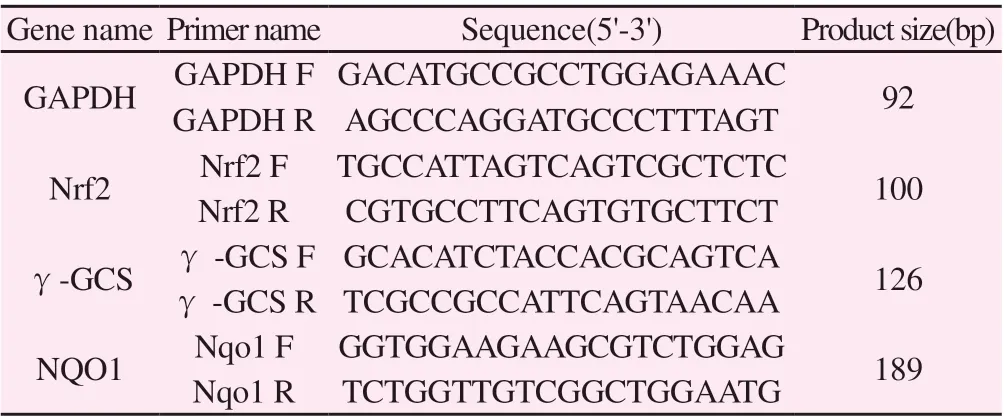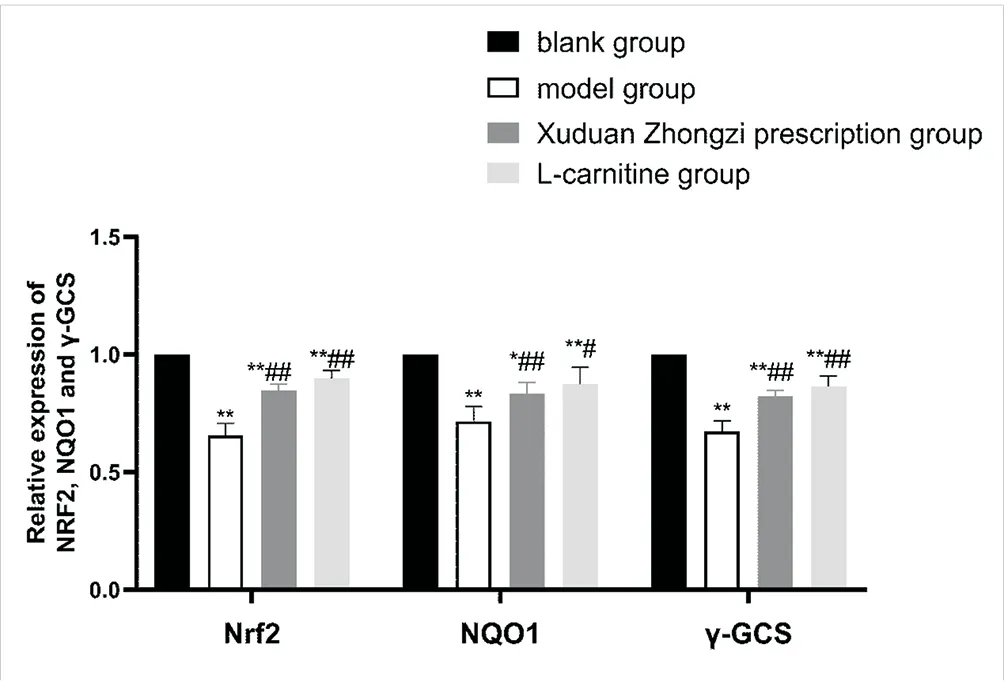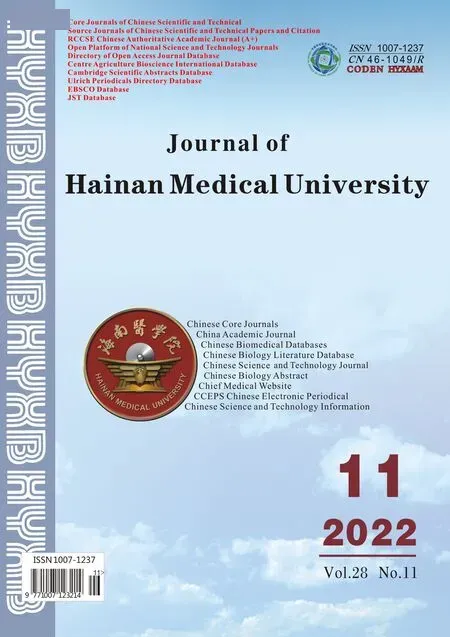An exploration on the protective mechanism of Xuduan Zhongzi prescription against epididymis oxidative damage in oligoasthenospermia model rats based on Nrf2-NQO1/γ-GCS signaling pathway
Zi-Li Lin, Yu Wang, Lu Chen, Liu Chen, Ya-Guang Zhang, Quan-Sheng Wang
1. Guangxi University of Chinese Medicine Graduate School, Nangning 530001, China
2. Department of Andrology,Guangxi University of Chinese Medicine, Nangning 530023, China
Keywords:Oligoasthenospermia Epididymis Oxidative damage Nrf2-NQO1/γ-GCS signaling pathways Xuduan Zhongzi prescription
ABSTRACT Objective: To investigate the protective mechanism of Xuduan Zhongzi prescription against epididymal oxidative damage in oligoasthenospermia model rats. Methods: Forty SD rats were randomly divided into blank group, model group, Xuduan Zhongzi prescription group (10g/kg)and L-carnitine group(0.1g/kg). Except blank group, all induced oligoasmospermia. The blank group and model group were given normal saline intragastric administration, the Xuduan Zhongzi prescription group was given Xuduan Zhongzi prescription solution intragastric administration, and the L-carnitine group was given L-carnitine intragastric administration.HE staining was used to observe the epididymis structure after 8 weeks. The concentration and activity rate of epididymis sperm were measured by sperm quality. MRNA and protein expression levels of Nrf2, NQO1 and γ -GCs in epididymis were detected by RT-qPCR and immunohistochemistry. Results: ①HE staining: in the blank group, the epididymis tubes were arranged tightly and regularly, the tissue structure was complete, the epithelial cells were arranged orderly, and the lumen sperm were numerous and evenly distributed. The epididymis of model group showed structural atrophy, loose arrangement, enlarged mesenchyme,increased cell debris and significantly reduced sperm cells. Compared with the model group,the lumen lesions of epididymis in Xuduan Zhongzi prescription group and L-carnitine group were significantly improved, and the amount of normal sperm in lumen was increased and the distribution was uniform. ② Results of sperm quality comparison among each group: sperm density and sperm motility rate: compared with blank group, sperm density and sperm motility rate in other groups were significantly decreased (P < 0.05), and sperm density and sperm motility rate in model group were significantly decreased (P < 0.05); Compared with model group, the sperm density and motility rate in Xuduan Zhongzi prescription group and L-carnitine group were significantly increased (P < 0.05). ③RT-qPCR and immunohistochemistry:Compared with the blank group, the mRNA and protein levels of Nrf2, NQO1 and γ -GCs in epididymal rats in model group were significantly decreased (P<0.05), while the mRNA and protein levels of Nrf2, NQO1 and γ -GCs were significantly increased in L-carnitine group and Continua seed formula group (P<0.05). Conclusion: Xuduan Zhongzi prescription can reduce oxidative stress damage and improve sperm quality of oligoasthenospermia. The mechanism may related to promoting the activation of Nrf2-NQO1/γ-GCS pathway in epididymis of oligoasthenospermia rats, and up-regulate the expressions of Nrf2, NQO1 and γ-GCS proteins.
1. Introduction
Oligoasthenospermia is one of the most important causes of male infertility. Early clinical research treatment of OLIGOASTHENOSPERMIA patients, the selection of Dipsacus Seed to treat, with good efficacy [1]. The pathogenesis of oligoasthenospermia is closely related to oxidative stress[2]. Nuclear factor-related erythroid like 2(Nrf2) activates the downstream antioxidant enzymes oxidoreductase-1(NQO1)and γ-glutamylcysteine synthetase (γ-GCS), thus playing an antioxidant role, stable sperm homeostasis [3-4]. The preliminary basic experimental studies have proved that Dipsacus asper seed can improve the anti-oxidative stress ability of spermatogenic cells and improve the quality of sperm by regulating the activity of antioxidant enzymes [5]. Whether duduan seed recipe can reduce oxidative stress injury and improve sperm quality through Nrf2-NQO1/γ-GCS signaling pathway in rats with asthenospermia has not been reported. Based on the above research foundation, this experiment used to establish oligo-asthenospermia model rats, to study the effect of Dipsacus asper seed formula on Nrf2, NQO1, γ-GCS related protein in the treatment of oligo-asthenospermia model rats,objective to explore the mechanism of Dipsacus asper seed formula on improving the oxidative damage of rat epididymis.
2. Materials and Methods
2.1 Laboratory animals
Purchase of 40 male SD rats [ Changsha Tianqin Biotechnology Co., Ltd., animal license: SCXK (Hunan)2019-0014], age 6-8 weeks,body weight 200g-220g. Cage kept in the animal room, free diet,free diet, free water, every cage every 3 days to replace the sawdust bedding. Rearing environment: indoor temperature maintained 19~ 25 C, humidity maintained 55% ~ 65%. This experiment was approved by the Guangxi University of Chinese Medicine.
2.2 Experimental instruments
Paraffin embedding machine (Leica, Germany); table-top refrigerated centrifuge (Eppendorf, UK); semi-automatic rotary slicing machine (Thermo Shandon, UK); pathological tissue rotisserer (Hoslyn, Changzhou); Optical biomicroscope (Olympus);sperm counting board and color sperm quality detection system(Beijing Weili Co., Ltd.).
2.3 Experimental reagent
Animal tissue total RNA extraction kit (Beijing tiangen Biochemical Technology Co, Ltd.); 2 × ChamQ Universal SYBR qPCR Master Mix, HiScript II Q RT SuperMix for qPCR (+ gDNA wiper)(Nanjing Novisan Biotechnology Co., Ltd.); Nrf2 antibody was purchased from Affinity (batch number: AF0639), NQO1 antibody from Affinity (batch number: DF6437) and γ-GCS antibody from Affinity (batch number: DF8550).
2.4 Experimental drugs
Xuduan Zhongzi prescription cube is prepared by Jiangyin River Pharmaceutical Co., Ltd. , composition: Cuscuta, Eucommia,Dipsacus root, achyranthes bidentata, fructus ligustri, fructus lycii,radix codonopsis, rhizoma ATRACTYLODIS, Rhizoma Dioscoreae 15 mg each, traditional Chinese medicine formula granule (drug license number: 1203002) ; L-carnitine oral solution 10ml: 1G(Northeast Pharmaceutical General Factory Production, Chinese medicine standard word H19990372) ; cyclophosphamide powder injection (Baxter company, import drug registration number:H20160467) .
2.5 Experimental methods
2.5.1 Animal grouping and modelingAfter 1 week of adaptive feeding, rats were randomly divided into blank group, model group, Xuduan Zhongzi prescription group and L-carnitine group, 10 rats in each group, except blank group, the remaining 3 groups were induced hypoasthenospermia models by intraperitoneal injection of 3.5 g/L normal saline at a dose of 0.035 cyclophosphamide for 7 days.
2.5.2 AdministrationAfter the success of the model, the rats were given 10g/kg of Xuduan Zhongzi prescription solution and 0.1 g/kg of L-carnitine oral solution. Once a day for 8 weeks.
2.5.3 Specimen preparation and detection of epididymal sperm quality
The epididymal tissue of rats was cut off the neck, and the epididymal tissue was taken from the epididymis of rats, and the epididymal tissue was cut up in 10 ml normal saline, incubated at 37 C for 5 minutes, then shaken to free the sperm, then the sperm was counted on the sperm counting board, sperm concentration and sperm viability were measured by computer assisted sperm analysis(CASA).
2.5.4 The epididymis was observed by hematoxylin-eosin staining
The epididymis was fixed with 4% paraformaldehyde, dehydrated with ethanol, transparent with xylene, embedded, sectioned, stained with Hematoxylin-Eosin, and observed under light microscope.
2.5.5 RT-qPCR was used to detect the expression of NRF2,NQO1 and γ-GCS in epididymis
The total RNA was extracted by Trizol method, the concentration and purity of RNA were detected, the concentration of RNA was adjusted to 1 μg, and the cDNA was retranscribed according to the instruction. By adding primers (see Table 1) and SYBR-Green reagent into the system, the cDNA was amplified by a threestep method on Roche-LightCycler-480 real-time fluorescence quantitative PCR, and the mRNA expression of each group was calculated by ΔΔCT = (objective gene CT-objective internal reference gene CT)-(blank gene CT-blank internal reference gene CT) was used to calculate the 2ΔΔCTof each group, that is, the multiple expression of messenger RNA acid (mRNA) and the mRNA of control group were obtained. The primer sequence is shown in Table 1:

Table1 RT-qPCR specific primer sequence
2.5.6 The expression of NRF2, NQO1 and γ-GCS in epididymis was detected by immunohistochemistry
The expression of NRF2, NQO1 and γ-GCS in the epididymis of rats was detected by immunohistochemistry. The expression of NRF2, NQO1, γ-GCS in each group was observed under light microscope.
2.6 Statistical analysis
The results were expressed by x ± s and SPSS 22. 0, ANOVA was used to analyze the variance of each group.
3. Results
3.1 Grouping results
The rats in each group showed decreased activity, decreased drinking and eating, weight loss, dry hair, decreased spontaneous activity frequency, and delayed reaction, one week after the drug intervention, the above situation gradually improved. The left carnitine group, the model group and the Xuduan Zhongzi prescription group all died, the death factors were: 2(1 in the model group and 1 in the L-carnitine group) died because the dose and weight calculation were not accurate enough, in the course of gastric perfusion, only 1 rat died due to rupture of esophageal blood vessel and puncture of stomach (1 rat in the Dipsacus Seed Square Group).So we ended up with 37 rats.
3.2 Semen quality comparison of rats in each group
Sperm density and motility: compared with the blank group, the sperm density and motility of the other groups were significantly lower (p < 0.05), and that of the model group was significantly lower (p < 0.05), the sperm density and motility were significantly increased in both the Xuduan Zhongzi prescription group and the L-carnitine group (p < 0.05). See Table 2.
3.3 Histopathological changes of rat epididymis
In visual field, the epididymal ducts in the blank group were arranged in a close order, with complete tissue structure and regular arrangement of epithelial cells. In the model group, the lumen of epididymis was atrophied, arranged loosely, stroma became larger,cell fragments increased and sperm cells decreased significantly.Compared with the model group, Xuduan Zhongzi prescription group and the L-carnitine group of Dipsacus had significant improvement in the pathological changes of epididymis lumen, and the normal sperm weight in lumen increased and distributed evenly,as shown in Fig. 1.

Figure 1 pathological results of epididymis in each group
3.4 Comparison of Nrf2、 NQO1、 γ-GCS mRNA expression in epididymis of rats in each group
The results of real-time fluorescent quantitative polymerase chain reaction (RT-qPCR) showed that the expression of NQO1, NQO1,γ-GCS mRNA in epididymis of model group was significantly lower than that of control group (p < 0.05), the expression of NRF2,NQO1, γ-GCS mRNA was significantly increased in Xuduan Zhongzi prescription group and L-carnitine group (p < 0.05), as shown in table 3 and Figure 2.

Figure 2 expression of Nrf2, NQO1, γ-GCS mRNA in rat epididymis
Table2 Semen quality comparison of rats in each group (±s)

Table2 Semen quality comparison of rats in each group (±s)
Group n Sperm concentration(x106/mL) Rate of activity(%)blank group 10 51.47±3.13 63.15±2.12 model group 9 11.49±1.39 20.65±1.86 Xuduan Zhongzi prescription group 9 34.42±3.45 41.13±2.33 L-carnitine group 9 33.00±3.45 35.32±1.60 F 269.331 743.531 P.000 .000

Table3 Comparison of relative expression of NRF2, NQO1, γ-GCS mRNA in epididymis of rats in each group
3.5 Comparison of Nrf2、 NQO1、 γ-GCS protein expression in epididymis of rats in each group
NRF2, NQO1 and γ-GCS of epididymis in each group were detected by immunohistochemistry. NQO1, γ-GCS and Nrf2 were lower in model group (Fig. 3b, fig. 4b, fig. 5b) The positive expression of brown and yellow color was significantly higher in the Xuduan Zhongzi prescription group, L-carnitine group Nrf2,NQO1, γ-GCS (Fig. 3C, 3d; fig. 4C, 4d; Fig. 5C, 5D), the positive expression of NRF2, NQO1 and γ-GCS was highest in blank group(Fig. 3a, Fig. 4a, fig. A).

Figure 3 expression of Nrf2 protein in epididymis of rats in each group (IHC ×200)

Figure 4 expression of NQO1 protein in epididymis of rats in each group(IHC × 200)

Figure 5 expression of γ-GCS in epididymis of rats in each group (IHC × 200)
4. Discussion
Oligoasthenospermia is one of the most important factors that cause male infertility at present. Oligoasthenospermia has many causes,such as oxidative stress, genital tract infection, varicocele and varicocele, which affect each other, causing oligoasthenospermia [6].Recent studies suggest that the pathogenesis of oligoasthenospermia is closely related to oxidative stress injury. The reason is that the double bond of sperm plasma membrane is damaged by reactive oxygen species (Ros), and the unsaturated fat of sperm plasma membrane is damaged by peroxidation. At the same time, the inner and outer membrane of mitochondria were destroyed, and the related apoptosis protein was activated, which resulted in sperm death [7-8].Oligoasthenospermia belongs to the related category of "Jing Leng", "Jing Shao" and "Jing Zhuo" in TCM. In recent years, many scholars, according to the theory of "kidney hiding essence" and"congenital basis", think that kidney deficiency is the main etiology and pathogenesis of this disease, which is related to liver depression and spleen deficiency Based on the literature research and clinical practice of the research group, the main etiological factors and pathogenesis of this disease are "the deficiency of nourishing qi, deficiency of kidney essence and deficiency of nourishing qi", which can be interpreted as the deficiency of part of Qi and blood in epididymis, kidney controlling reproduction, the main collection of essence, kidney and spleen are used for each other in the production of essence and blood. The spleen governs transport,absorbs the essence and micro-substances in grains and converts them into blood. They nourish each other, strengthen the spleen and replenish the kidney essence, if the spleen and kidney are combined,the essence and blood provide nutrients. If the spleen is out of circulation, the nutrients will not flow from the body, the Qi and blood will be insufficient, leading to the imbalance between nutrition and health. The blood vessels of the epididymis can't supply blood and nutrients, leading to the malnutrition, sperm can't mature;if the kidney essence deficiency, then qi and blood stagnation,meridian obstruction, jing luo blocked, blocked the path of transport nutrition, sperm vitality, and ultimately lead to sperm passage is not sterile. This prescription is derived from YUEFUJIA's "medical positive print volume": "Strengthening the kidney, strengthening the spleen and promoting sperm production", yue fu-jia believed that the function of the spleen is the main source of nutrition for men after birth. If the Qi and blood are full, the kidney essence will overflow and the seed of spermatogenic seed will never cease.Fangzhong cuscuta, medlar, Ligustrum lucidum, yam, atractylodes macrocephala, Codonopsis Pilosula in order to invigorate the spleen,kidney health; The combined use of various drugs has the effect of invigorating the spleen and kidney, promoting blood circulation and promoting essence. Modern pharmacology confirmed that the main components of this prescription include total flavonoids [9-10]in dodder and medlar, oleanolic acid [11] in Ligustrum lucidum,saponins [12] in Dipsacus Root, Eucommia ulmoides polysaccharide[13] with antioxidant, scavenging free radicals, improving oxygen utilization rate and so on.
In recent years, it has been found that the peroxide, or oxidative stress, of the reproductive system has become a common feature of male infertility [14]. Oxidative stress is caused by the imbalance between the production of oxygen free radicals and the antioxidant capacity in the body [15], in which Ros is a reactive oxygen species with high activity is a measure of whether the body has an important index of antioxidant capacity [16]. NRF2 maintains the redox Dynamic equilibrium by activating the transcription of antioxidant enzymes, and is an important transcription factor that regulates redox processes in cells [17], it has the functions of anti-apoptosis [18],maintaining redox homeostasis [19] and anti-inflammatory reaction
[20]. Under normal conditions, NRF2 is inactivated in the cytoplasm by binding to Kelch-like-ECH-associated protein 1(Keap1), and is in an inactive state if exposed to oxidative stress, nrf2 is no longer in a steady state, so it detaches into the nucleus, binds to antioxidant response elements (Ares), and then regulates the expression of downstream proteins such as NQO1 and γ-GCS, enhancing cell antioxidant capacity and reducing oxidative stress injury [21-22].It was found that Nrf2/ARE signaling pathway could regulate the expression of NQO1 and γ-GCS, increase the expression level of NRF2, NQO1 and γ-GCS, and improve the body resistance,modulating antioxidation mechanism, alleviating spermatogenic dysfunction and improving sperm motility [23-24]. The results showed that compared with the blank group, the sperm density and the sperm activity rate of the other groups were significantly lower(p < 0.05), and the sperm density and the sperm activity rate of the model group were significantly lower (p < 0.05), the sperm density and motility were significantly increased (p < 0.05) in Xuduan Zhongzi prescription Group and L-carnitine Group, which proved that Xuduan Zhongzi prescription could improve sperm quality. The levels of NQO1 and γ-GCS in the model group were significantly lower than those in the treatment group and the model group. NRF2,NQO1 and γ-GCS in the model group were significantly higher than those in the treatment group.
To sum up, Dipsacus asperoides seed formula can reduce oxidative stress injury and improve sperm quality in oligoasthenospermia rats,and its mechanism may be to promote activation of NQO1/γ-GCS signal pathway in epididymal tissue of oligoasthenospermia rats,upregulation of NRF2, NQO1 and γ-GCS protein expression is correlated.
Author's contribution:
Lin Zili: data collation and analysis, writing papers; Wang Yu:Model Building; Lu Chen: model building, drug intervention;Chen Liu: indicator testing; Zhang Yaguang: in charge of the article proofreading, improvement; Wang Quansheng: Head of research and tutor.
There's no conflict of interest between the authors.
 Journal of Hainan Medical College2022年11期
Journal of Hainan Medical College2022年11期
- Journal of Hainan Medical College的其它文章
- Study on the mechanism of “Salvia chinensis and Radix Ranunculi Ternati” drug pair in the treatment of lung cancer
- Potential targets and mechanism of Xingxiao Pill for the treatment of lung cancer were analyzed based on network pharmacology and molecular docking
- Effect of total glucosides of paeony on serum cytokines in patients with psoriasis and its clinical efficacy: A meta-analysis
- Effects of post-dilation on coronary blood flow and MACE events following primary percutaneous coronary intervention in patients with STEMI
- Correlation study between dendritic cell and eosinophil in refractory rhinosinusitis
- Effects of compatibility of Scutellaria baicalensis stems and Polygonum cuspidatum on TRPV1 expression and inflammatory cytokines in rats with acute lung injury
